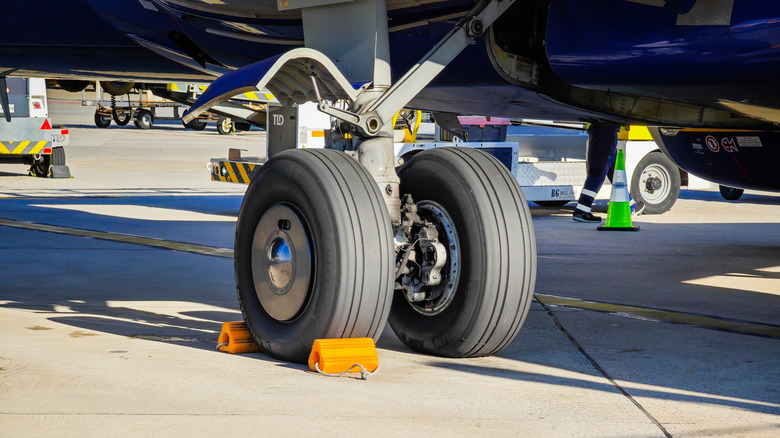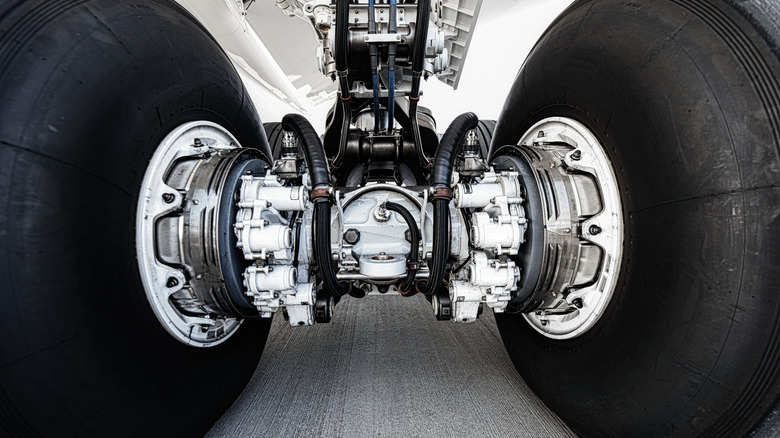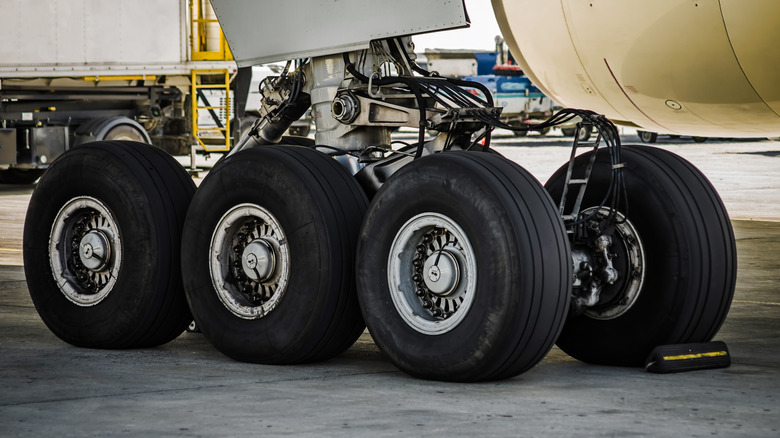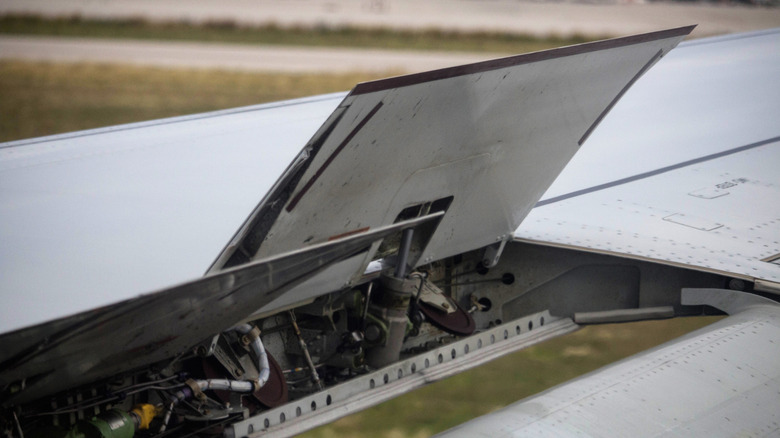How Do The Brakes On A Commercial Jet Work?
The majority of time a commercial jet is in motion, it's up in the air, where the traditional laws of motion that govern our cars don't quite apply the same way. However, it's important to remember that jets aren't always in the air. They have to take off from the ground as well as land, and during these brief periods, they need to crib a little bit from their road-traversing little siblings.
In order to safely traverse the runway and account for the occasional rejected takeoff, not to mention coming to a complete and proper stop while landing, a commercial jet needs brakes in the wheels of its landing gear. A pilot has multiple brake pedals at their feet to individually engage the jet's wheel brakes, which are controlled via a series of hydraulic pumps and rotating discs lined with high-friction materials.
Conceptually, these disc brakes have some similarities to the brakes you'd find on a car, albeit scaled up to account for a jet's substantially greater size and weight. In fact, that size and weight are the major deciding factor in exactly how elaborate and multifunctional a jet's braking system will be, with larger jets requiring more braking discs in the wheels, not to mention other methods of slowing like wing spoilers and reverse thrusters.
All jet brakes are engaged with hydraulic pumps
No matter what kind of jet a pilot is flying, they all share the same basic framework of braking, a similar one to the brakes on your car. When the jet needs to come to a stop on the ground, the pilot pumps the brakes using a toe-operated pedal. One pedal operates the left brake while the other operates the right brake; only these wheels have brakes, while the wheels on the jet's nose and tail don't.
When the pedal is pushed, a hydraulic pump funnels braking fluid into a chamber above the corresponding wheel, similar to the fluid in your car's brakes. As the pressure increases from the fluid, a caliper is engaged within the wheel, pressing a pair of pads into the wheel's braking disc. Normally, the disc spins at the same rate as the wheel, but when the disc is sandwiched in, the rotation of the wheel is gradually slowed down. It's the same idea as the brake pads in your car, though the use of multiple pedals for multiple brakes does give the pilots a much greater degree of control over how the jet slows and stops.
Larger planes require more braking discs
The major difference between the brakes in a jet and the brakes in your car is that even the smallest jet is exponentially larger and heavier than most cars. Small jets may only need one braking disc to safely slow down, but as the jet's size increases, braking power also needs to scale up to accommodate.
This is why, including a single-disc brake, there are four types of jet braking setups. The next up from single-disc brakes are dual-disc systems, which invert the sandwich setup of a single-disc system. Rather than one disc between a pair of pads, you have two discs sandwiching a center carrier, which is lined with the same kind of material as brake pads. When the brakes are engaged, the discs squeeze in and connect with the carrier, slowing their rotation.
If a jet is particularly large and heavy, too much for a single to dual-disc setup, the next option up is a multiple-disc setup. If the other brake types are sandwiches, these things are seven-layer dips. Steel stators and braking discs are layered onto a bearing carrier in an alternating pattern, with each stator covered in brake pad material. When the brakes are engaged, the entire stack is squeezed together to generate the requisite stopping friction.
A slight variation of the multiple-disc setup is the segmented rotor system. The basic principle is the same, with multiple discs squeezed between braking materials. The difference is that the discs are slotted or segmented, which helps the excessive heat created by the braking process to safely ventilate out instead of building up.
Jets use more than just their brakes to slow down and stop
As big and powerful as jet brakes can get, even they aren't always enough to stop a jet by themselves. You have to remember, we're talking about hundreds of thousands of pounds of metal flying in at hundreds of miles per hour. It's one thing for a jet's brakes to gently stop it while it's taxiing on the runway, but a post-flight landing is a much different beast. If a jet tried to slow and stop after a landing with its brakes alone, they'd probably break from the intense heat.
To alleviate this, jets have several additional means of slowing themselves that are used in concert with the landing gear wheel brakes. For instance, extendable spoilers are deployed on the wings to create additional wind resistance, increasing the jet's drag. Additionally, reverse thrusters are activated on the engines, redirecting the air they take in to fire backwards and increase the drag further. Landing gear brakes may be the star of the show when it comes to stopping a jet, but it's a sizable production with a cast full of vital players.



